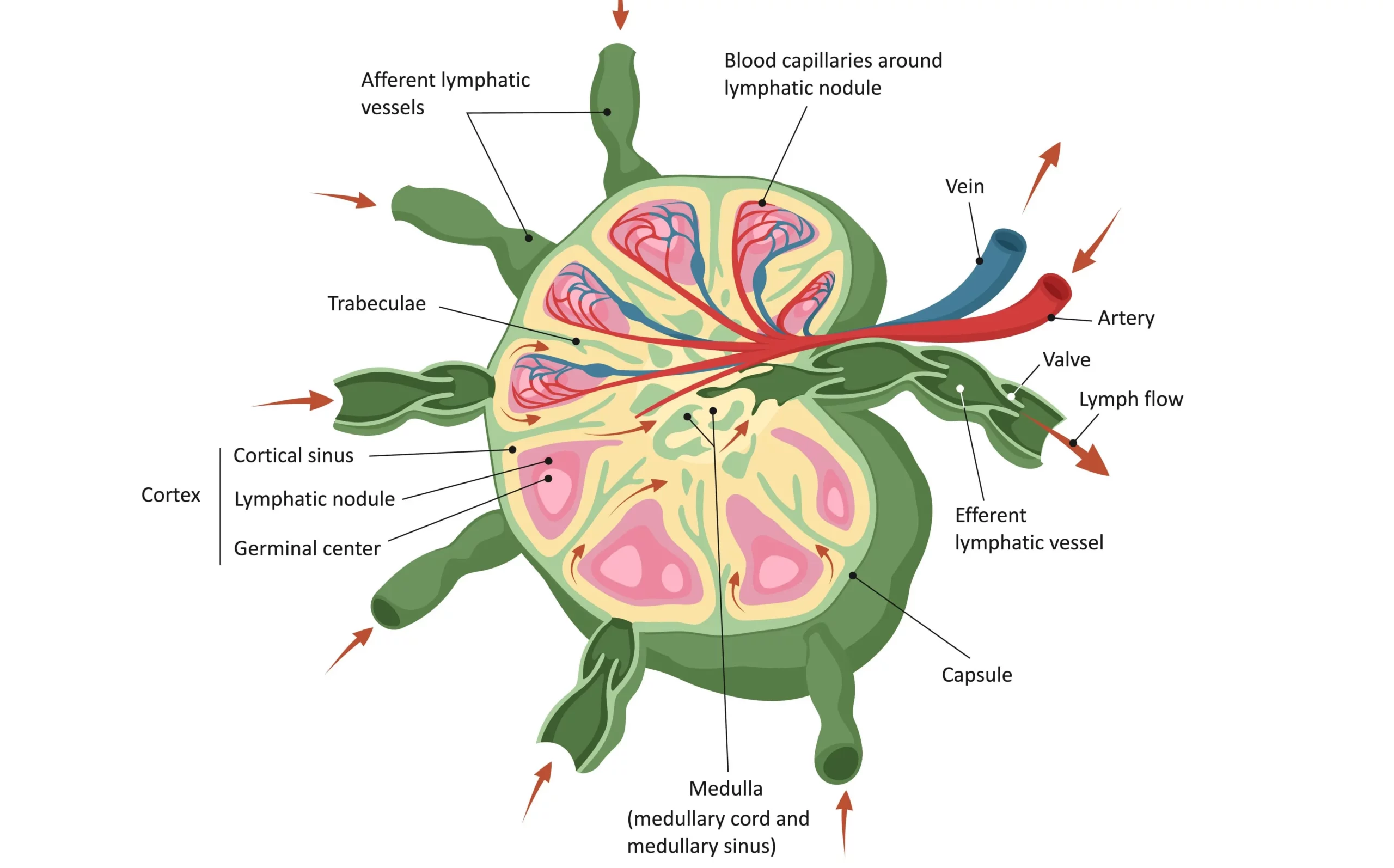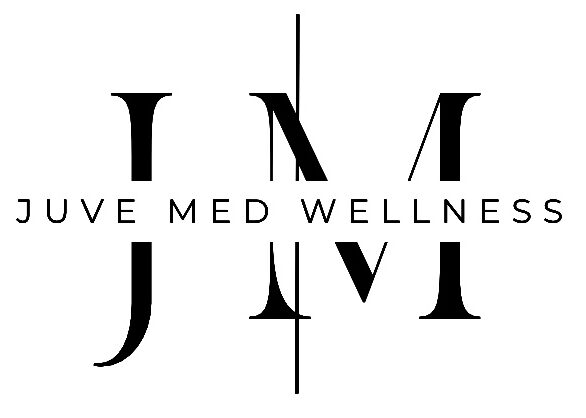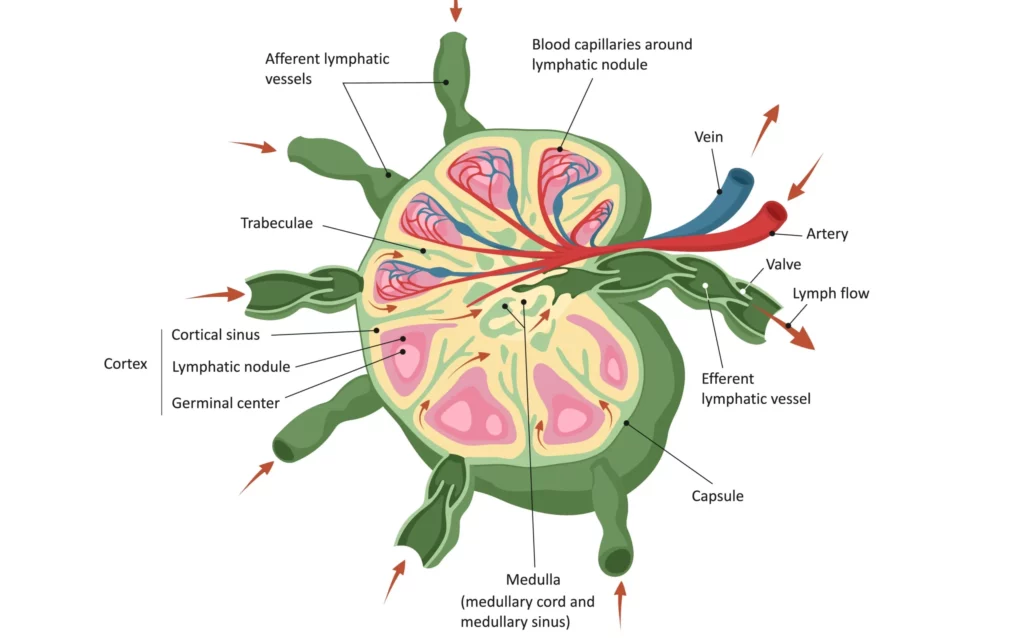The lymphatic system functions include immune responses, maintaining fluid balance, and absorbing fats along with fat-soluble vitamins. This system is made up of a network of organs, tissues, vessels and nodes.
The word lymph comes from the Greek nymph and Latin lympha, both associated with freshwater deities—a fitting origin for a system that is all about fluid movement and purification. Ancient texts like the Edwin Smith Papyrus (c. 1600 BCE) and the works of Hippocrates, Aristotle and Galen first mention the lymphatic system functions and structure.
Lymphatic vessels go to almost all organs, except for areas like the cornea or those shielded by immune barriers like the blood brain and blood nerve barriers. Despite being closely related to the circulatory and immune systems, people often neglect the lymphatic system more than the cardiovascular system, even though it’s central to overall health. Lymphatic tissue is throughout the body and supports immune functions.
Interstitial fluid—plasma that seeps from capillaries into body tissues—forms the clear fluid that circulates through this system, called lymph. It carries proteins, nutrients, immune cells, pathogens, cellular debris and waste. By gathering and filtering this material the lymphatic system keeps internal cleanliness and immune vigilance. Capillaries, including those in the skin, absorb lymph and eventually return it to the bloodstream.
This article covers the many lymphatic system functions, its main components and the diseases and conditions that affect it.
Lymphatic System Components and their functions
Lymphatic Vessels
Like veins, lymphatic vessels have thin walls and start as microscopic lymph capillaries in tissues. These veins gather extra interstitial fluid and move it through bigger and bigger vessels. Respiratory action, muscle contractions and one-way valves all move lymph. Eventually two main ducts direct lymph:
Thoracic duct: Empties lymph into the left subclavian vein from most of the body.
Right lymphatic duct: Drains the right side of the head, chest and right arm into the right subclavian vein.
Lymph Nodes
In the human body there are 400-800 small bean-shaped lymph nodes in areas like the neck, armpits, chest, abdomen and groin. Their main function? They are filtration hubs that clean lymph of cancer cells, bacteria, viruses and damaged cells. Immune defenders like B-cells, T-cells, dendritic cells and macrophages inspect and purify lymph before it goes back into the bloodstream. These defenders either neutralize or eliminate threats during this process. Besides this defense function, lymph nodes are crucial players in lymphatic system functions as secondary lymphoid organs that launch adaptive immune responses.
Each node has several components:
- The capsule, which forms a protective outer shell.
- Subcapsular sinuses, a network of channels that direct lymph into the node.
- Inside the cortex, lymphocytes trigger immune reactions.
- At the core, the medulla supports both immune activity and lymph filtration.
- Afferent vessels bring lymph into the node.
- Efferent vessels allow cleaned fluid to exit.

Organs Supporting Lymphatic System Functions
- Bone Marrow: Produces lymphocytes and blood cells.
- Thymus: Matures T-cells beneath the breastbone.
- Spleen: Stores immune cells, filters blood and recycles red blood cells.
- Tonsils and Adenoids: Trap infections swallowed or breathed in through the nasal passages and throat.
- MALT (Mucosa-Associated Lymphoid Tissue): Defends mucous membranes in the respiratory, urogenital and digestive systems.
- Peyer’s Patches and Appendix: Monitor gut microorganisms in the intestines.
- Liver: Although not a typical lymphatic organ, the liver removes waste and toxins from the blood and contributes to immune response. This, too, supports lymphatic system functions indirectly.
Lymphatic System Functions
Fluid Balance
Every day 20 liters of plasma leave the blood capillaries. 17 liters go back into the bloodstream and 3 liters are collected by the lymphatic system. Otherwise this extra fluid accumulates and causes swelling or edema – and in chronic cases lymphedema.
1–1- Fluid Balance in Chronic Heart Failure
In chronic heart failure (CHF) the lymphatic function is impaired. The increased venous pressure overloads the system and it can’t return the interstitial fluid, so the lymphatic system maintains tissue homeostasis.
1-2- Relationship with Blood Circulation
The lymphatic system pumps fluid back into the bloodstream against pressure gradients. It uses one way valves and smooth muscle contractions aided by tissue movement and respiration.
One of the most important physiological functions of the lymphatic system is its relationship with blood circulation. This is especially true in fluid balance. As fluid leaves the blood capillaries into the interstitial spaces the lymphatic vessels collect the excess and return it to the blood. This is the circuit.
Compared to the extensive reach of the blood vessels (estimated to be 100,000 km in total length) the lymphatic network is shorter. But it follows the path of the major arteries and veins. It drains into the blood via lymph-venous anastomoses in the neck and even at the base of the heart.
1-3- Selective Fluid Reabsorption
Every day in a 70 kg adult the blood capillaries filter about 5 liters of fluid. The lymphatics reabsorb a significant amount back into the blood, especially after partial reabsorption in the lymph nodes where the oncotic pressure difference between blood and lymph drives this exchange. So the lymphatic system ensures optimal flow throughout the body’s tissues.
Under normal conditions blood capillaries reabsorb fluid only in select areas like the kidneys, intestines and lymph nodes. Elsewhere the lymphatic system takes over.
Although the traditional models like Starling’s principle once suggested more fluid reabsorption into the blood, newer knowledge now says otherwise. The selective permeability of the blood vessel walls and the dominant role of the lymphatics prevails.
Fat Absorption: A Key Lymphatic Function
Lacteals—lymphatic vessels in the small intestine lining—absorb dietary fats and fat-soluble vitamins. These fats are packaged into a milky fluid called chyle. The lymphatic system transports chyle into the bloodstream to support the body’s nutritional needs. Furthermore, this process also involves the skin and deeper tissue layers in lymphatic transport.
Immune Support and Defense
The lymphatic system forms the foundation of the immune response. It:
Detects and filters pathogens from lymph
Houses and produces lymphocytes (B-cells and T-cells)
Initiates immune responses via lymph nodes and lymphoid organs
Creates immune memory for future responses
B-cells produce antibodies. T-cells target and destroy infected or cancerous cells. Immune responses often begin in lymph nodes, which swell during infection due to increased lymphocyte activity.
The lymphatic system also maintains tissue fluid homeostasis and immunity. Many conditions—lymphedema, cancer spread, chronic inflammation—stem from its dysfunction. The movement of immune cells through lymph nodes supports this defense and proves crucial for the immune system.
Conditions and diseases of the lymphatic system functions
Swollen Lymph Nodes (Lymphadenopathy)
Immune system problems, malignancies, and infections (such as strep throat, mononucleosis, and HIV) commonly cause this. Localized or widespread swelling may occasionally follow with fever, exhaustion, or weight loss. Unusual lymph node enlargement, such as above the collarbone, may indicate a serious illness.
Normal cell growth, as in reactive or infectious processes; abnormal cell infiltration, as in malignant processes; nodal tissue necrosis that causes suppuration, or foreign material deposition within the node, as in lipid storage disorders, all enlarge lymph nodes.
Lymphedema
An initial lymphatic injury or dysfunction and the following activation of a pro-inflammatory cascade place the lymphatic system in a state of chronic inflammation and lead to lymphedema, an incurable illness of the lymphatic system.
A malfunction in the lymphatic pump mechanism causes fluid to build up and create chronic swelling when collecting veins cannot move lymph. This causes a persistent accumulation of lymphatic fluid, frequently in the limbs, and usually stems from:
- Cancer therapies (radiation or surgery)
- Infections (like lymphatic filariasis)
- Birth defects
- Soft tissue swelling, heaviness, discomfort, and infection risk are among the symptoms.
Inflammation and Infections
Lymphadenitis: A lymph node infection.
Lymphangitis: Inflammation affects lymph vessels.
Tonsils: In tonsillitis, inflammation affects the tonsils and causes a sore throat and trouble swallowing.
Mesenteric lymphadenitis: Children frequently experience inflammation of the abdomen nodes.
Genetic and Autoimmune Conditions
Castleman disease: Lymphatic cells overgrow.
Autoimmune Lymphoproliferative Syndrome (ALPS): Lymphocytes accumulate abnormally.
Lymphangiomas: Congenital cystic growths form in lymphatic vessels.
Lymphangioleiomyomatosis: Lymphatic tissue overgrows in a rare lung condition.
These illnesses and other disorders may significantly impact overall health and lymphatic function.
Cancer
Lymphoma: Lymphocytes become cancerous—includes Non-Hodgkin Lymphoma (various subtypes) and Hodgkin Lymphoma (with Reed-Sternberg cells).
Leukemia: Affects lymphatic organs and bone marrow, among other blood-forming tissues.
Metastatic Cancer: Cancer spreads to other organs via the lymphatic system.
Body Systems & Lymphatic Functions
The circulatory system
The circulatory and lymphatic systems work closely. As fluids, nutrients, and waste items flow between blood vessels and tissues, the lymphatic system returns extra fluid and removes waste.
Immune System
The lymphatic system, part of the immune system, actively produces and distributes immune cells, detects antigens, and initiates responses against infections and abnormal cells.
The respiratory system
The respiratory system facilitates lymphatic flow by creating pressure changes during breathing and helping lymph move through the channels. These motions also maintain the normal flow through lymphatic tubes.
How to Support Lymphatic System Functions
To maintain proper lymphatic health, you should:
- Stay hydrated
- Exercise regularly
- Eat nutritious foods
- Reduce toxin exposure
- Elevate limbs and use massage
- Support natural drainage and detox the lymph system
When to Get Medical Help
Seek care if you experience:
- Persistent or painful swollen lymph nodes
- Unexplained fever, fatigue, or weight loss
- Swelling in arms or legs
- Frequent infections
In Conclusion
The lymphatic system forms an essential and dynamic part of human biology. It helps the body absorb nutrients, maintains fluid equilibrium, and boosts immunity. Although it mainly operates in the background, its organs, arteries, and immune cells greatly influence health and prevent disease. To sum up, by understanding its functions, you can significantly improve overall well-being. Healthy lifestyle choices maintain lymphatic health, and early detection of dysfunctional symptoms and seeking medical advice when needed ensure this essential system continues to defend and support you in the best way.
References:
https://my.clevelandclinic.org/health/body/25209-lymph
https://my.clevelandclinic.org/health/body/21199-lymphatic-system
https://www.medicalnewstoday.com/articles/303087#lymphedema
https://www.betterhealth.vic.gov.au/health/conditionsandtreatments/lymphatic-system
https://my.clevelandclinic.org/health/body/23131-lymph-nodes
https://www.verywellhealth.com/lymphatic-system-diagram-function-anatomy-diseases-5209610
https://www.ahajournals.org/doi/full/10.1161/CIRCRESAHA.123.322867
https://link.springer.com/article/10.1186/s13578-022-00898-0
https://www.nature.com/articles/s41577-023-00965-8
https://www.jacc.org/doi/full/10.1016/j.jacc.2021.05.021
https://www.annualreviews.org/content/journals/10.1146/annurev-fluid-122316-045259
https://link.springer.com/article/10.1186/s13578-022-00898-0
https://www.annualreviews.org/content/journals/10.1146/annurev-fluid-122316-045259
https://www.sciencedirect.com/science/article/pii/S0169409X20301241
https://www.sciencedirect.com/science/article/abs/pii/S0022346820307077


